SQL Frameworks
Nowadays, the majority of the Java backends are using some sort of the permanent storage SQL being the most dominant in the market. The default API to communicate with the SQL databases is a specification called JDBC (a bunch of Java interfaces that database developers must implement in order to let the end users talk to the Database over the wire). The problem is that using plain JDBC is hard for a regular developer because of
- All queries must be written manually
- The parsing of the data transferred over the wire must be done manually(using ResultSets)
- Most of the methods from JDBC API throw checked exceptions which forces developers to deal with blobs of try catch statements
- All transactions must be opened and closed manually
There are many frameworks that help you to deal with the problems mentioned above. According to 2022 survey by Josh Long the most popular frameworks are
- JPA(Hibernate or EclipseLink)
- raw JDBC wrappers (such as Spring based JdbcTemplate class)
- JOOQ
- MyBatis All of them solve the problems above in different and unique ways.
Today however we want to show how FusionReactor can help regular developers to work with the listed frameworks
Hibernate
Hibernate is one of the oldest and most mature ORM framework in the Java world. Being a JPA implementation it solves JDBC problems by replacing direct, persistent database accesses with high-level object handling functions. The most important feature is the mapping Java classes into corresponding SQL tables. Hibernate uses data manipulation over the Java classes and generates proper SQL statements. In order to test Hibernate with FusionReactor we will use a simple SpringBoot project with spring-data as an even higher level of abstraction over Hibernate. Here is the schema
CREATE TABLE users
(
ID BIGINT PRIMARY KEY AUTO_INCREMENT,
name varchar(255)
);
create table orders
(
ID BIGINT PRIMARY KEY AUTO_INCREMENT,
price double precision,
user_id BIGINT references users (ID)
);One user has many orders. First of all we need to generate mapping classes for both tables(Lombok will be used to auto-generate POJO methods)
@Entity
@Data
@Table(name = "users")
class User {
@Id
@GeneratedValue(strategy = GenerationType.AUTO)
private Long id;
@Column(name = "name")
private String name;
@OneToMany(cascade = CascadeType.ALL)
@JoinColumn(name = "user_id")
private Set<Order> items = new HashSet<>();
}
@Table(name = "orders")
@Entity
@Data
@NoArgsConstructor
@AllArgsConstructor
class Order {
@Id
@GeneratedValue(strategy = GenerationType.AUTO)
private Long id;
private double price;
private String name;
@ManyToOne(fetch = FetchType.LAZY)
@JoinColumn(name = "user_id")
private User user;
Order(double price, String name) {
this.price = price;
this.name = name;
}
}Next we need to create a repository interface
public interface UserRepository extends JpaRepository<User, Long> {
}Finally, we need to set up the configuration in property/yml file
spring.datasource.url=jdbc:h2:mem:testdb
spring.data.jpa.repositories.bootstrap-mode=defaultThe last two lines allow you to see a formatted SQL generated by Hibernate in the console. Lastly, to test it we will use a simple Rest Controller that
- Fires
Thread.sleepevery 5th call to simulate long-running queries - Throws an exception every 3rd call to simulate a business level error
@RestController
@RequestMapping("/users")
public class UserController {
private final UserRepository userRepository;
@GetMapping("/save")
public Long save() {
final int condition = this.cnt.getAndIncrement();
if (condition % 2 == 0) {
TimeUnit.SECONDS.sleep(3);
}
final User user = new User();
user.setName(UUID.randomUUID().toString());
user.setItems(
Set.of(
new Order(12.0, "Banana"),
new Order(12.0, "Apple")
)
);
this.userRepository.save(user);
if (condition % 5 == 0) {
throw new RuntimeException("Business error");
}
return user.getId();
}
}Let's send some traffic to the backend and see what insides FusionReactor will give us
#!/bin/bash
for i in {1..100}
do
curl http://localhost:8080/users/save
done
(The source code is available here)
Transaction details
First of all we can the list of all DB transactions (Transactions -> History)

As you can see some of them have failed , some took 3000ms(3 sec) and
succeeded and others only took a few milliseconds.
Let's see if FusionReactor can help us to understand why some of these
transactions have failed.
If you click on the details button(the book icon next to the transaction ) you
will see the page with all the transaction details
 First 3 links are HTTP Request specific so we will skip them for now and will
keep our focus on SQL part
First 3 links are HTTP Request specific so we will skip them for now and will
keep our focus on SQL part
JDBC
JDBC page gives you the JDBC summary
- The time it took to execute all the queries
- All the queries executed by the transaction
As you can see ,a single transaction has executed 8 queries. Doesn't seem what you want to have from saving a single user with 2 orders
Relations
Relations page is particularly useful because it shows you
all the queries in a hierarchical order
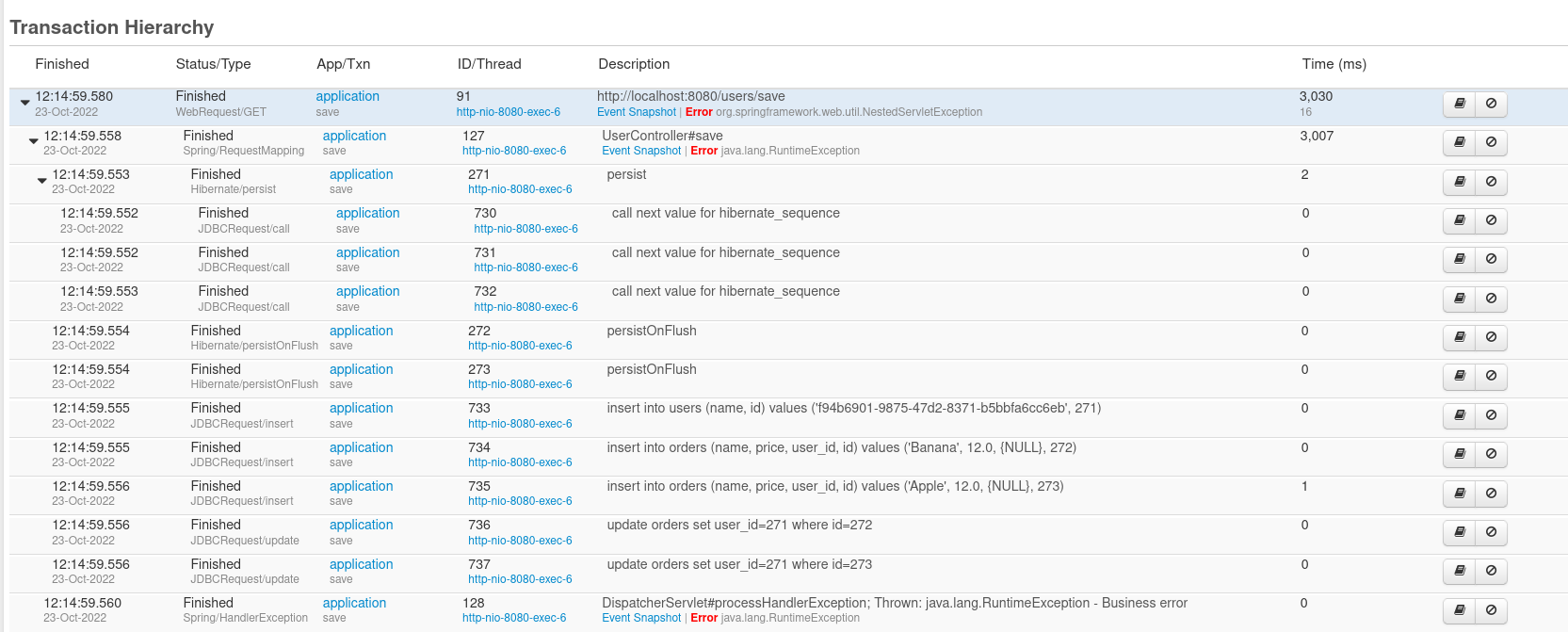 Let's break down this list
Let's break down this list
- Hibernate has generated 3 primary keys from the given sequences
- 1 query to insert the user
- 2 queries to insert two orders(notice that user_id is null for both orders)
- 2 update queries to set user id to newly created orders
(If you want to know how to optimize mapping to decrease the amount of queries we highly recommend this wonderful blog post from Vlad Mihalcea)
Event snapshot
Another important page that can help you to understand the root cause of the
error is Event Snapshot
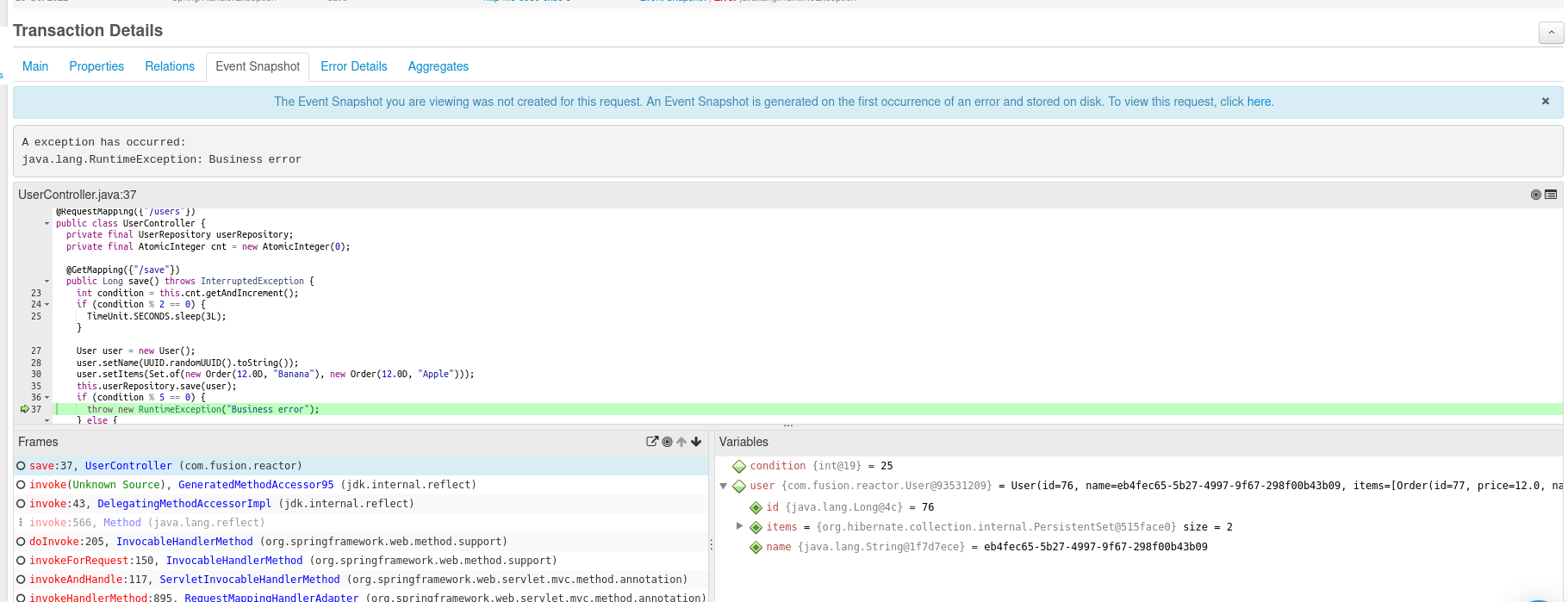
This page shows you:
- The decompiled source code will show you the line where this error has been thrown
- The stacktrace on the left bottom corner can help you to understand the request cycle
- Variables page on the bottom right shows you all the variables which were
present before the error (the
conditionint was 25)
JDBC
All the insides described above were only a part of the Transactions page.
FusionReactor can show you much more
in the JDBC page.
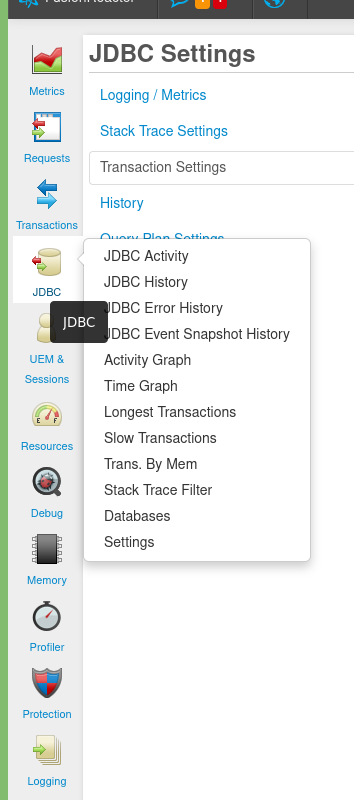 The first important part that you should go through is a Settings tab
The first important part that you should go through is a Settings tab
Settings
Setting allows you to customize the FusionReactor behaviour in different ways
starting from
settings your own threshold for long transactions and ending with query plan
generation for long transactions(helps teams to decide whether the particular
query will benefit by introducing an index)
By default, Spring Boot can generate and print SQL queries generated by
Hibernate and while this feature is useful, it has one limitation namely
All prepared statement parameters are hidden with placeholders ?. On the other
hand, as you have seen previously, FusionReactor shows
the queries with all corresponding SQL arguments. While this feature can be
really
helpful in the local development where
you can directly copy the sql statement and paste it into your RDMS of choice to
make some tests, the
feature can be dangerous in the production environment leaking user credentials
when customers are trying to log in into your application. We highly recommend
to
disable this feature in production(Can be done within the Setting page)
Longest transactions
One of the main differences between the Longest Transactions in Request and JDBC
pages is that JDBC one only shows you how long each SQL query took.
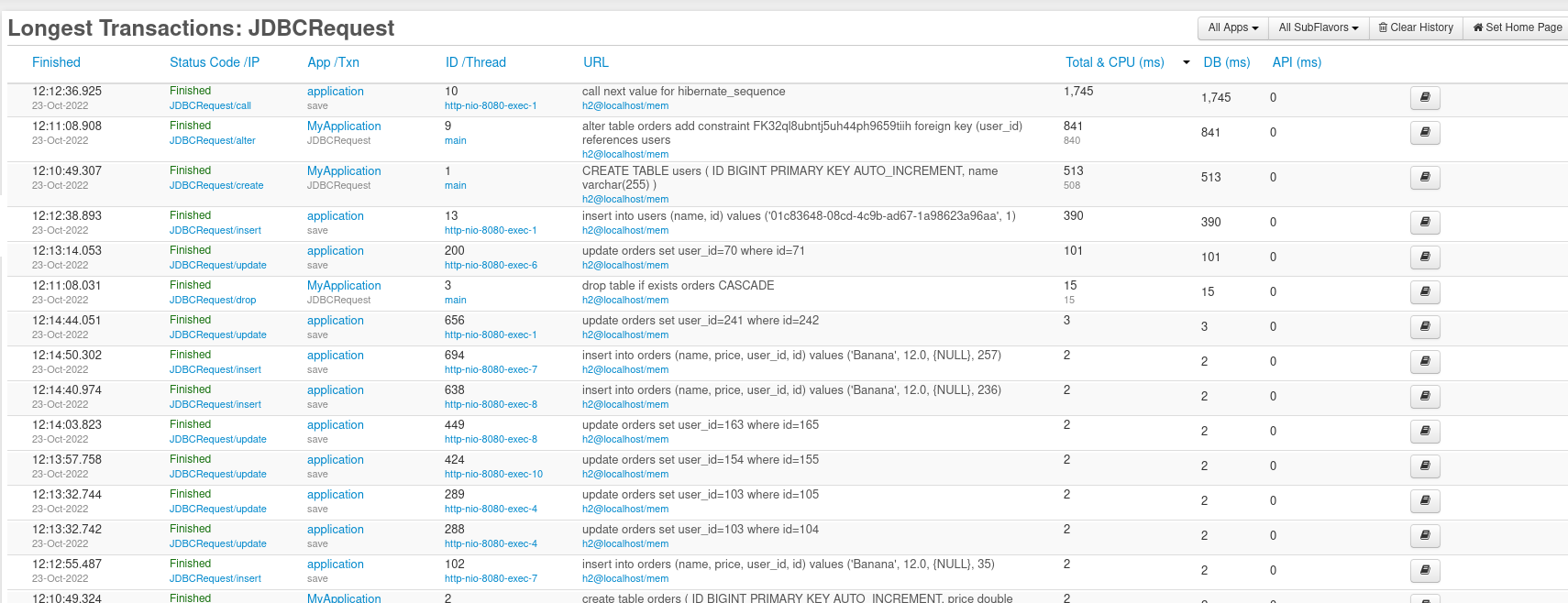 As you can see there are no transactions that took 3 seconds
because
As you can see there are no transactions that took 3 seconds
because Thread.sleep that we call in the Controller level is not a part of the
query. Another thing is that all transactions in this list have succeeded ,
despite the fact that Java throws an error it doesn't affect whether the
query itself will fail.
As an example let's change the schema a little and make the order
name(name varchar(255) unique) to be unique.
In this case if you try to run the same load test again you will see that some
transactions have failed
 As always , clicking on details page will show you Event Snapshots with detailed
information
As always , clicking on details page will show you Event Snapshots with detailed
information
Graphs
To better visualize the jdbc statistics, FusionReactor provides two graphics
- Time graph
- Activity graph
The time graph shows historical average durations of the following jdbc requests
- Completed
- Active
- Failed
 The time interval is configurable and all the transactions are persisted
The time interval is configurable and all the transactions are persisted
On the other hand, the activity graph shows you the counts for listed requests. It can help you to visualize the peak traffic on your websites.
Error history
The error history page only shows the JDBC level errors(while Request history
shows you the HTTP request level errors )
 As can be seen from the image above, the only JDBC error so far is unique
violation constraint on insert
As can be seen from the image above, the only JDBC error so far is unique
violation constraint on insert
Database
Last but not list is a Database page which shows you a nice break-down of all
JDBC activities using pie charts
 The pie charts show you
The pie charts show you
- Total time by queries
- Total time by tables
- Query counts by operation
- Query counts by table
Metrics
One of the main metric types supported by JVM is JMX. Configured JMX beans can
be monitored and reconfigured on runtime. One of the most important part to
monitor in backend apps is a database connection pooling.
By default, Spring preconfigures Hikari connection pool and by adding this line
into your config file spring.datasource.hikari.register-mbeans=true it will
generate corresponding MBeans that you can see in Metrics page
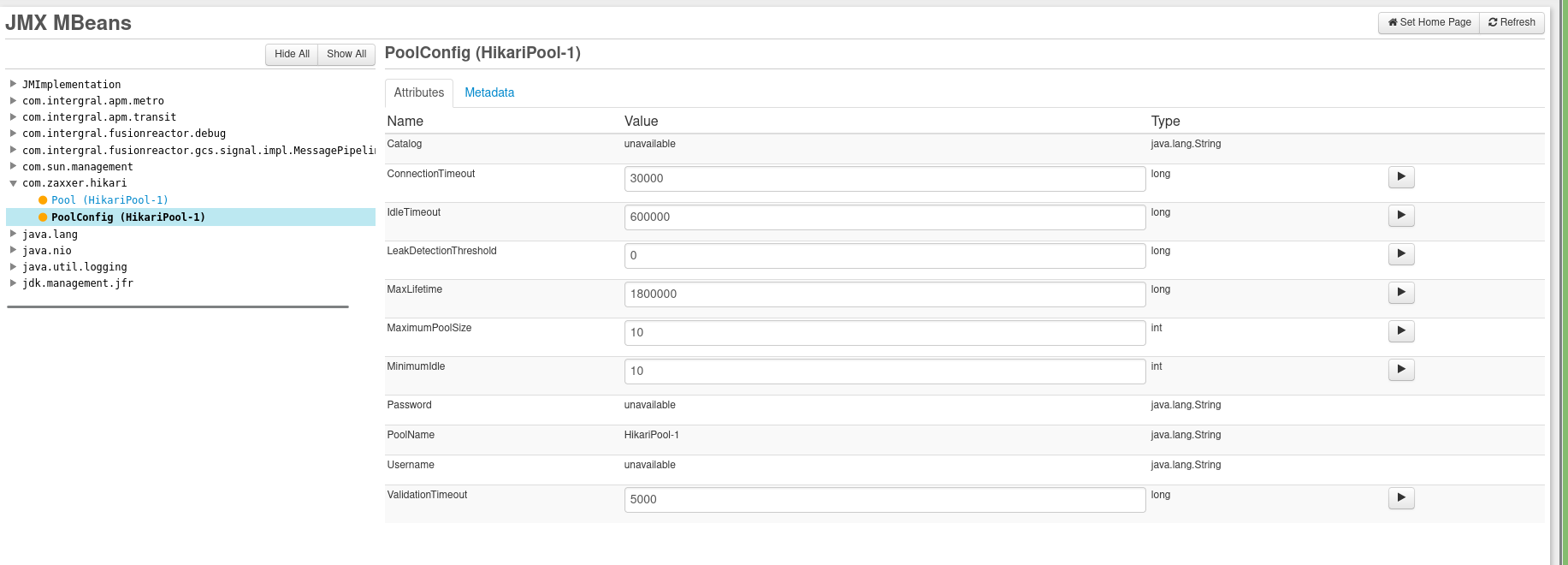 All the settings are configurable and can be monitored using the start icon. The
metrics then can be exported to CloudWatch if you are using AWS infrastructure
All the settings are configurable and can be monitored using the start icon. The
metrics then can be exported to CloudWatch if you are using AWS infrastructure
Hibernate pitfalls
Hibernate as a framework has a deep learning curve. There is a lot of
reflection manipulation going on under the hood.
In Spring boot, by default , the database transaction is opened on the
controller level. Why
does it happen ? If you load an entity that has a lazy collection and then want
to
use the collection, the session in controller level will fire a separate SQL
query to fetch the data for this collection from Database. The problem here
is that database transactions must be opened once they are required(preferably
in the Service layer), otherwise the long-running transactions will force the
connection pool to create new DB connections to serve new users. To disable
this behaviour you need to
pass this line into your config file spring.jpa.open-in-view=false.
Let's run the load test again. If you check the JDBC history,however, you won't
see
any anomalies. But if you open the Transaction Details
in Transactions->History page and then go to Relations to see transaction
Breakdown you will notice that Hibernate has opened 3 separate transactions
instead of 1
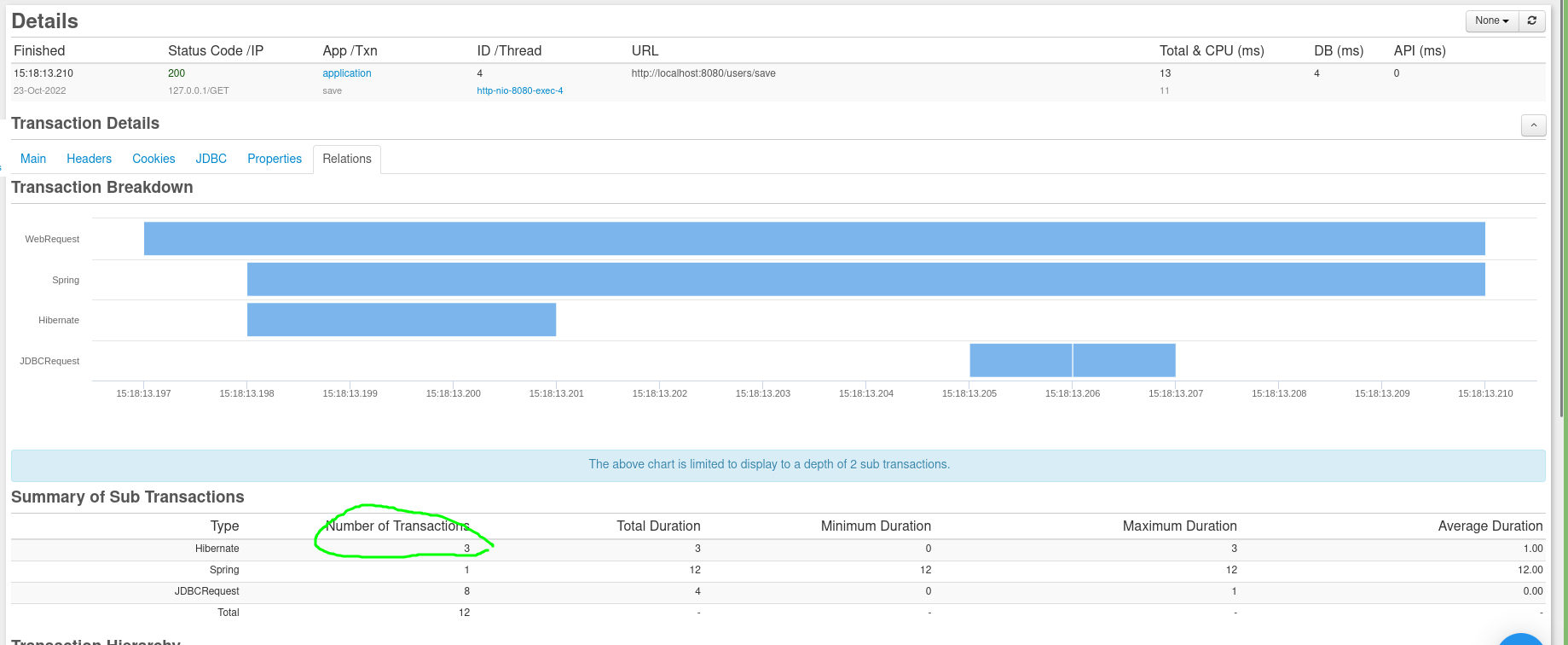 To fix this problem simply add
To fix this problem simply add @Transactional annotation on top of the save
method
MyBatis
As we have seen, Hibernate simplifies the persistent layer. However, the developer must understand what's going on under the hood in order to optimize the default framework's behaviour. On the other hand, there is another popular Java framework, that doesn't do a lot of "black magic" under the hood, namely MyBatis. According to documentation
MyBatis is a first class persistence framework with support for custom SQL, stored procedures and advanced mappings
The developers who use MyBatis have full control over the SQL queries using a user-friendly xml or annotation based API(with an introduction of multiline Strings in java 14 the Annotation API should be preferred). Let's rewrite the previous example using MyBatis. First we need to get rid of all JPA specific annotations from Entity classes. Next we have to write sql on our own using xml files. For this example we will rewrite the Repository class that saves user with corresponding orders(Code examples are available here) Here is the Mapper class
@Mapper
public interface UserMapper {
void saveUser(User user);
void saveOrders(@Param("orders") List<Order> orders, @Param("userId") long userId);
default void saveUserWithOrders(User user) {
this.saveUser(user);
this.saveOrders(user.getOrders(), user.getId());
}
}and here is the corresponding xml file
<mapper namespace="com.fusion.reactor.UserMapper">
<resultMap id="UserResultMap" type="com.fusion.reactor.User">
<id column="id" property="id"/>
<result column="name" property="name"/>
</resultMap>
<insert id="saveUser" parameterType="com.fusion.reactor.User" useGeneratedKeys="true" keyProperty="id" keyColumn="id">
INSERT INTO users (name)
VALUES (#{name})
</insert>
<insert id="saveOrders" parameterType="map">
INSERT INTO orders (
price,user_id,name
)
VALUES
<foreach collection="orders" item="order" index="index" open="(" separator="),(" close=")">
#{order.price},
#{userId},
#{order.name}
</foreach>
</insert>
</mapper>As you can see we explicitly wrote two queries, first to save the user and
second to save a list of orders. No autogenerated queries and no automapping as
in Hibernate. Everything has to be done manually. Let's run load tests again and
see JDBC transaction history.
 FusionReactor will show you that MyBatis indeed generated queries that you
specified with all the parameters displayed, so you can verify that mappers are
working as expected
Going to Relations page in transaction detail for one of the requests we can see
that single request used 1 transaction and 2 jdbc queries
FusionReactor will show you that MyBatis indeed generated queries that you
specified with all the parameters displayed, so you can verify that mappers are
working as expected
Going to Relations page in transaction detail for one of the requests we can see
that single request used 1 transaction and 2 jdbc queries
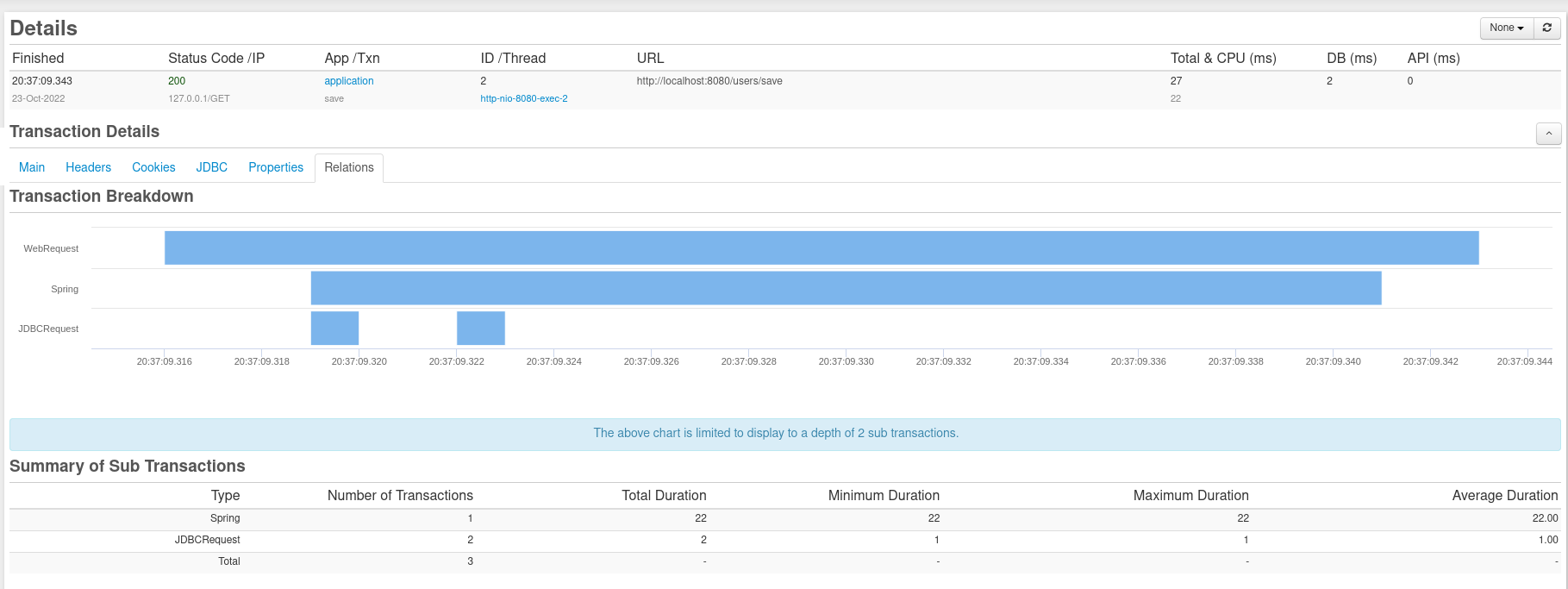
The MyBatis plugin for intellij has a language server support to write type safe xml files, however if you want a compile time support there is another framework to consider
JOOQ
The last SQL framework that we will cover today is JOOQ. According to the official website
jOOQ generates Java code from your database and lets you build type safe SQL queries through its fluent API.
JOOQ is different from two previous frameworks in that it generates java classes
from SQL tables on compile time. All compiled java classes are part of the
classpath and can be accessed during development. As latest spring-boot-jooq
starter does not support H2 we will
use Postgres as a RDMS(source code is
available here)
.
First we need to run mvn clean install to generate java classes. Next we will
write same query that saves user and two orders but using JOOQ API.
@RestController
@RequestMapping("/users")
public class UserController {
@Autowired
private DSLContext dslContext;
@GetMapping("/save")
public long save() {
final Record1<Integer> id = this.dslContext.insertInto(Tables.USERS)
.columns(Tables.USERS.NAME)
.values(UUID.randomUUID().toString())
.returningResult(Tables.USERS.ID)
.fetchOne();
final Integer userId = id.getValue(Tables.USERS.ID);
this.dslContext.insertInto(Tables.ORDERS)
.columns(Tables.ORDERS.USER_ID, Tables.ORDERS.NAME, Tables.ORDERS.PRICE)
.values(userId, "Banana", 12.5)
.values(userId, "Apples", 13.0)
.execute();
return userId;
}
}FusionReactor works with JOOQ the same way as it works with all other
frameworks. All generated classes will be stored in the jar file, so you don't
have to do anything else to integrate JOOQ with FusionReactor.
After running load testing we can see in JDBC history tab that JOOQ indeed just
uses two sql queries

JOOQ is easier to use than MyBatis because of the compile time checking from the compiler ,syntax highlighting from your editor and auto mapping from SQL tables to java classes. It is however not as powerful as Hibernate in that you still need to write all queries on your own.
Conclusion
All 3 frameworks have their niche among java developers. Still, nowadays most companies prefer Hibernate in order to speed up the development time, while other companies prefer lighter frameworks such as JOOQ and MyBatis in order to have full control over the SQL and as a result write more optimized code without relying on sql generated by JPA. FusionReactor supports all of these frameworks and can give you insides of underlying SQL queries executed by your code and performance metrics for each individual query. As you have seen, with FusionReactor it's really easy to see whether Hibernate behaves the way you expect. If you are interested, please book a demo with us or just download a trial.